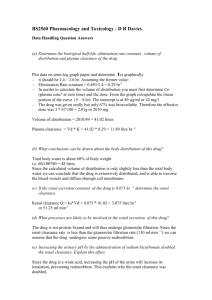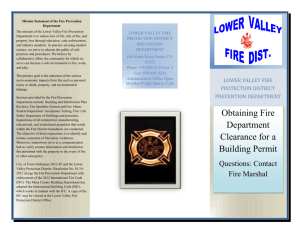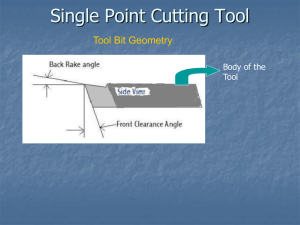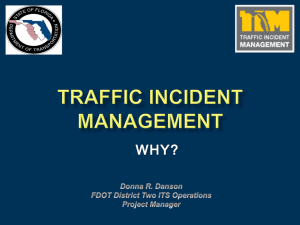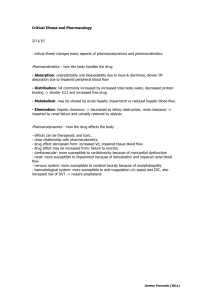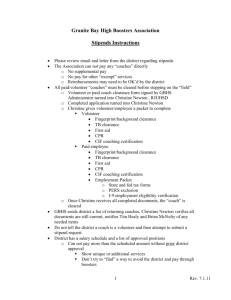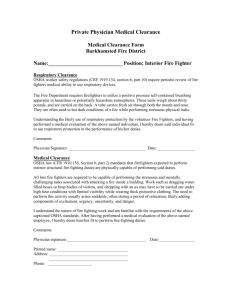Dev. Date
advertisement
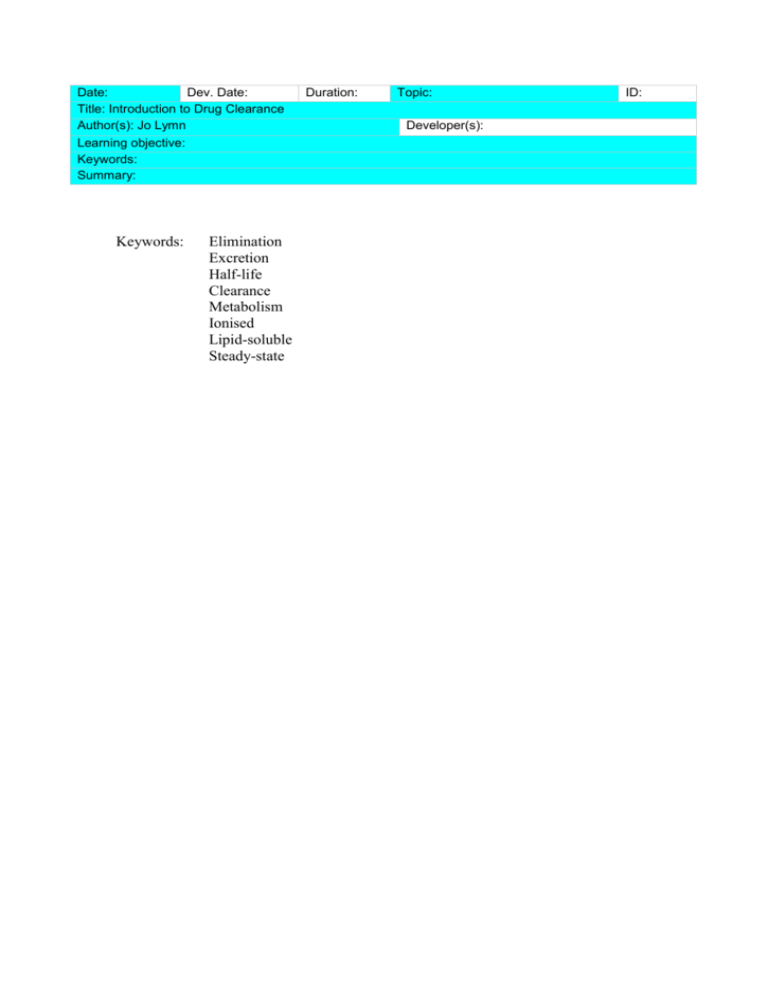
Date: Dev. Date: Title: Introduction to Drug Clearance Author(s): Jo Lymn Learning objective: Keywords: Summary: Keywords: Elimination Excretion Half-life Clearance Metabolism Ionised Lipid-soluble Steady-state Duration: Topic: Developer(s): ID: Presentation: Images etc: What do we mean by drug clearance? Drug clearance is concerned with the rate at which the active parent drug is removed from the body and for most drugs at steady state clearance remains constant so that drug input equals drug output. Clearance is defined as the rate of drug elimination divided by the plasma concentration of the drug. Drug clearance is influenced by age and by disease with a reduction in drug clearance being associated with an increase in the half-life of the drug and an increase in clearance being associated with a decrease in the half-life of the drug. Picture of bucket with line around inside (From one of Heathers RLOs?) Add water from tap (labelled ‘drug in’) and have water coming out of hole in bucket (labelled ‘drug out / cleared’) so that fluid level remains constant at the line (label fluid in watering can as active parent drug in body). Show equations on screen Clearance = rate of drug elimination Drug plasma concn Drug Input = Drug output Drug clearance affected by have words ‘Age’ and ‘Disease’ flashing upon screen. Total Drug Clearance Drug clearance involves the processes of both metabolism and excretion. Metabolic, or hepatic, clearance is the conversion of the parent drug to a different chemical entity by liver enzymes, particularly the cytochrome P450 family of enzymes. The key importance of metabolism is that it acts to make drugs less lipid soluble, more water soluble, and therefore easier to excrete from the body. Renal clearance on the other hand is the removal of the drug from the body by the kidneys. Relative importance of metabolism & excretion in drug clearance. The relative importance of metabolic and renal clearance is different for different drugs. Some drugs undergo mainly metabolic clearance and others undergo mainly renal clearance. One of the key factors which determines the importance of hepatic and renal clearance is the lipid solubility or degree of ionisation of the drug. Cell membranes are lipid in nature and hence lipid soluble, or unionised, drugs can readily cross cell membranes. These drugs will enter hepatocytes and are likely to undergo extensive hepatic clearance. If a drug is ionised however it will not be able to easily cross the membranes of the liver cells, or hepatocytes. It is therefore less likely to undergo Cltotal (total body clearance) = ClH (hepatic clearance) + ClR (renal clearance) Show drug molecules being injected into the body (red in colour). Moving round the body. Focus on the liver see red drug molecules turning blue as process of ‘metabolism’ is verbalised. Focus on kidney. See red molecules entering kidney tubule and being excreted in the urine as process of ‘excretion’ is verbalised. Show red drug molecules in blood stream entering the liver. Focus in on liver show some red drug molecules. Red drug molecules some uncharged some with charge attached. Show uncharged crossing membranes into liver cells and being transformed into blue and molecules while red molecules remain in the blood stream hepatic metabolism and more likely to undergo extensive renal clearance. For example the drugs furosemide and atenolol are cleared almost entirely by the kidneys. Hepatic clearance Hepatic clearance is dependent on a number of factors including hepatic blood flow, the rate of liver enzyme activity and the rate of secretion into the bile. Anything which impacts on these factors may impact on drug clearance, either speeding drug clearance up or slowing it down. For example competition between drugs for the metabolising enzymes in the liver, or genetic polymorphisms which alter the activity of these enzymes, will impact on hepatic clearance. Show the bucket from the previous image with a list of possible factors. Get students to move factors onto bucket to see what effect it will have. Bucket will either lose more water than it is gaining so fluid will drop below line (Clearance increased) or fluid loss will slow down and fluid in bucket will rise above line (Clearance decreased). Factors; Decreased blood flow to liver – clearance decreased Decrease in cytochrome P450 activity – clearance decreased Increase in cytochrome P450 activity – clearance increased. Renal Clearance. Renal clearance is dependent on a number of factors including renal blood flow, as well as the rates of glomerular filtration and tubular secretion compared to the rate of passive diffusion. Anything which impacts on these factors may impact on drug clearance either speeding drug clearance up or slowing it down. Lipid soluble, or unionised, drugs will undergo passive diffusion being reabsorbed into the blood stream while ionised drugs will be retained within the tubule. The degree of ionisation of drug in the kidney tubules is influenced by the pH of the urine and will affect the renal clearance. Following an overdose with aspirin the urine can be alkalinised, this changes the pH increasing the ionised fraction of the drug in the tubules, reducing passive diffusion and promoting clearance. Focus on kidney, blood flow contains charged and non charged aspirin molecules. Show filtering of both through glomerular capillaries. Show carriage of charged molecules across kidney tubule. With uncharged molecules moving back across tubule into blood stream. Have a pH scale on bottom. As student slides the pH level up then more drug becomes ionised and is retained in the kidney. Assessment: Blockbuster Game Four rows of 4 blue squares You must get from one side of the board to the other by answering the questions relating to the letters displayed. You can use any route and start with any square on the left hand side. Please see attached paper for blockbuster grid and questions and answers. Link 1 Link 2 Half-life RLO Vd RLO with initials in them. When student clicks on a square the relevant question comes on to the screen. If the student gets the question right then the square turns orange in colour. If the student gets the question wrong the following comes up ‘Sorry that is an incorrect answer, please try another square’ Link 3 www.icp.org.nz Interactive Clinical Pharmacology site developed in the Department of Clinical Pharmacology, Christchurch Hospital / School of Medicine, New Zealand, Glossary Glossary to come up only after the blockbuster game has been completed. See attached table for glossary Blockbuster Game CYP H GF C Symbol on Grid CYP H GF C M E F D B TS I K BF PD L HL M E F D B TS I K Question The family of enzymes found in the liver which act to metabolise drugs The name for liver cells A process important in renal clearance The term which is defined as the retae of drug elimination divided by plasma concentration A key process in drug clearance A key process in drug clearance A drug is almost exclusively cleared by the kidneys Something which can act to alter the rate of drug clearance in the body Secretion into here is a component of hepatic metabolism. A process important in renal clearance The term used to refer to a drug which is charged and thus not lipid soluble The body organ involved in renal clearance Something which impacts on both hepatic and renal clearance A process important in renal clearance The body organ involved in hepatic clearance A reduction in drug clearance is associated with an increase in this BF PD L HL Answer Cytochrome P450 Hepatocytes Glomerular Filtration Clearance Metabolism Excretion Furosemide Disease Bile Tubular secretion Ionised Kidneys Blood flow Passive diffusion Liver Half-life Glossary Term Elimination Half-life Definition The irreversible loss of drug from t.he body The time taken for the plasma concentration of a drug to reduce by 50% Clearance The rate of drug elimination divided by the plasma concentration of the drug Metabolism The enzymatic conversion of one chemical entity to another in order to make it less lipid soluble and hence easier to excrete. The removal of drug from the body Drug metabolising enzymes that are embedded in the smooth endoplasmic reticulum of liver cells Charged or polar in nature (not lipid soluble) A loop diuretic which is polar in nature and cleared almost exclusively by the kidneys A cardioselective beta adrenoreceptor antagonist which is polar in nature and cleared almost exclusively by the kidneys A liver cell A fluid secreted by the liver, stored in the gall bladder and released into the duodenum to aid the emulsification of fats. Bile can also contain drugs which have been metabolised in the liver. Changes in the genetic code which occur in a population and result in the production of enzymes, particularly cytochrome P450 enzymes, which as a result may be more or less active than the norm. One of three processes which are critical for renal clearance. Involves the filtration of 20% of renal plasma flow through the glomerular capillaries thus allowing drug molecules to diffuse into the glomerular filtrate. One of three processes which are critical for renal clearance. Involves the transfer of drug molecules to the tubular lumen by two independent, non-selective carrier systems. One of three processes which are critical for renal clearance. Involves the reabsorption of water and drug molecules across the tubule membranes and back into the plasma. A non-steroidal anti-inflammatory drug which exists as a weak acid. To make more alkaline, less acidic. In terms of alkalinisation of the urine this can be done to promote the excretion of drugs which are weak acids Steady state is said to have been reached when the concentration of the drug in the plasma does not drop below therapeutic levels between doses. Steady state is usually achieved after 4/5 half-lives of the drug. Excretion Cytochrome P450 Ionised Furosemide Atenolol Hepatocyte Bile Genetic Polymorphisms Glomerular Filtration Tubular secretion Passive diffusion Aspirin Alkalinise Steady State
